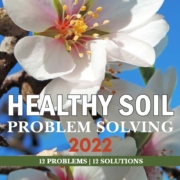New Resource Guide for Soil Sponge Knowledge
By Darron Gaus
It’s frustrating when you want your soil to be healthy, but challenges make the journey anything but easy. But help is here in the form of a great new resource from ACRES USA, called Healthy Soil Problem Solving Guide, that helps you solve key difficulties on your soil health journey. This great beginner to intermediate guide sets up 12 scenarios that you may be experiencing within your soil and offers quick, easy-to-read help to solve those problems.
If you are reading this blog and are part of the Soil for Water network, you are most likely on a journey to make your soil act as a sponge for water, whether you are in a flood area or a drought area. You may have already come across some problems and asked a peer in our network for help. Soils are so diverse that you may have already received a solution that starts with “It depends…” Repairing your soil sponge can be a tricky and difficult challenge.
Healthy Soil Problem Solving Guide begins with a fantastic article on the fundamentals of healthy soil. Much of the guide discusses 12 problems you might be experiencing in your soil and 12 solutions for how to approach these issues. What makes this guide so great is that its authors have approached the solutions without the “It depends…” stance on soil health but instead with general but immensely helpful guidelines for the thought process of repairing your soil sponge and health.
The 12 problems addressed in the guide range from water retention to soil degradation. It includes basics of chemistry, biology, and even input timing. The last section even includes advice on one of the greatest barriers to regenerating our soil health, “Capital Funding.” Most topics are covered in an easy-to-understand approach of labeling the problem, what you should do first to fix the problem, and how to know when the problem might be solved.
One of my favorite sections answers, “How does soil biology affect soil health?” The diversity of soil biology is challenging enough, but the way that the soil microbiome interacts with each other and the macrobiology in it is sometimes fascinating and infuriating at the same time. This guide keys in on the basics and makes it approachable and useful to all types of producers who utilize soil to grow their products. As farmers and ranchers, we are always looking for the right tool for the job. One of my favorite and most useful tools is having a growing, mental soil dictionary at the ready. This section explodes with great words that should be a part of all soil health practitioner’s intellectual property, such as, plant nutrition cycles, aggregate formation, soil structure, organic matter, moisture-holding capacity, and gas exchange.
Whether you are just starting on your soil sponge timeline, or you already have seen your soil get better through soil health practices, the Healthy Soil Problem Solving Guide can be tremendously helpful. You can download this guide free. Don’t forget that the Soil for Water Forum is extremely helpful for these problem-solving discussions, as well.



